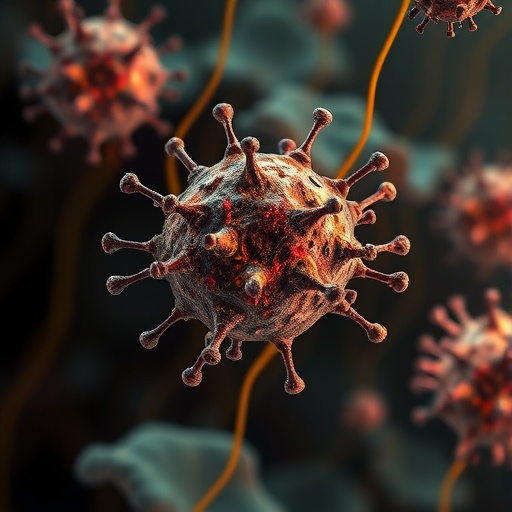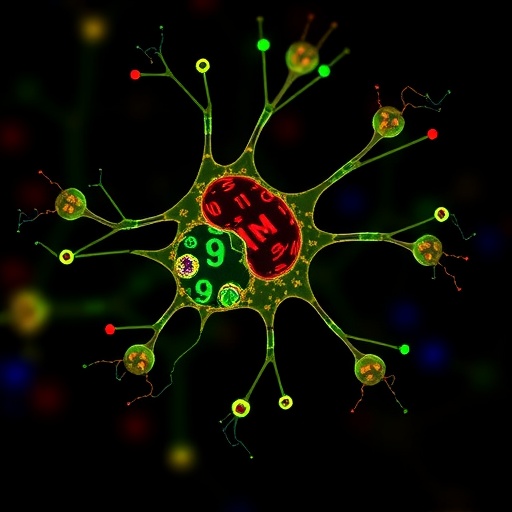In a groundbreaking study published recently in Cell Death Discovery, a team of international researchers has unveiled the intricate mechanisms through which gomesin peptides induce cytotoxic effects in cells. This discovery not only sheds light on the fundamental biology of these antimicrobial peptides but also opens up innovative therapeutic avenues aimed at exploiting lipid interactions for targeted cytotoxicity, potentially revolutionizing treatments for cancer and infectious diseases. The research provides unprecedented insights into the interplay between gomesin peptides and the glycosphingolipid pathways within cellular membranes, highlighting how these interactions mediate cell death.
Gomesin peptides, known primarily for their potent antimicrobial properties, have long intrigued scientists due to their ability to selectively kill harmful cells while sparing normal tissues. However, until now, the molecular mechanisms governing their cytotoxic behavior remained poorly understood. Through a series of meticulously designed experiments, Fernandez-Carrasco and colleagues have mapped out the pathway involving glycosphingolipids—a class of complex lipids predominantly found in the outer leaflet of the plasma membrane—as a critical mediator of peptide-induced cytotoxicity. These glycosphingolipids appear to serve as molecular docking sites that enable gomesin peptides to engage with the lipid bilayer more effectively.
Beyond simple binding, this study reveals that the interaction between gomesin peptides and glycosphingolipids is intricately linked with cholesterol-rich lipid domains, often referred to as lipid rafts. Lipid rafts are specialized microdomains that organize membrane proteins and lipids, orchestrating essential cell signaling events. The research team demonstrated that gomesin peptides preferentially target these cholesterol-enriched regions, disrupting the structural integrity and dynamics of lipid rafts. This perturbation results in a cascade of intracellular events culminating in cell death, a process the researchers hypothesize is integral to the peptides’ selective cytotoxic effects.
The use of advanced biophysical techniques, including fluorescence microscopy, lipidomics, and biophysical modeling, underscored the dual role of glycosphingolipids and cholesterol in modulating peptide activity. The authors detailed how the complex lipid environment of the membrane is essential in determining the degree and specificity of gomesin-mediated cytotoxicity. Notably, lipid composition variations among different cell types might explain differential susceptibility to these peptides, providing further evidence of their selective killing properties.
One of the most striking findings of this work is the identification of a lipid-dependent mechanism of action, diverging from classical protein-targeted cytotoxic approaches. This paradigm shift challenges long-held assumptions about peptide-mediated membrane disruption and suggests that therapeutic strategies could be fine-tuned by manipulating membrane lipid composition. Such an approach may enhance drug delivery and efficacy while minimizing off-target effects, a fundamental hurdle in treatment design.
In exploring the molecular intricacies of these interactions, the researchers also highlighted potential implications for combating drug-resistant bacterial strains. By elucidating the precise roles that glycosphingolipids and cholesterol play in the insertion and function of gomesin peptides, this research introduces new targets for antimicrobial development. Membrane lipid composition manipulation could render resistant pathogens more vulnerable to peptide treatment, heralding a novel class of antimicrobials that exploit lipid-mediated pathways.
Moreover, this study contributes valuable insights into the role of membrane lipids in cellular health and viability. The selective targeting of lipid rafts and glycosphingolipid-rich domains underscores the importance of membrane organization in cell fate decisions. Since dysregulation of lipid membrane dynamics is implicated in various diseases, including neurodegenerative conditions and metabolic disorders, the findings hold promise for broader biomedical applications beyond oncology and infection control.
The research methodology included the use of model membranes mimicking the complexity of natural cellular membranes, thereby ensuring that the observed peptide-lipid interactions are physiologically relevant. This approach allowed the team to dissect the contribution of specific lipid components, such as sphingomyelin and gangliosides, further clarifying their roles in facilitating or impeding cytotoxic activity.
Additionally, cell-based assays confirmed the in vitro observations, demonstrating that modulation of glycosphingolipid biosynthesis impacts the susceptibility of cells to gomesin peptides. Chemical inhibition of glycosphingolipid synthesis resulted in diminished peptide binding and reduced cytotoxicity, providing compelling functional evidence that directly links lipid metabolism to peptide effectiveness.
The implications of this study extend to oncology, where metabolic rewiring and altered lipid landscapes are hallmarks of many tumors. Targeting cancer cell membranes through glycosphingolipid and cholesterol pathways could provide a highly selective therapeutic window. Gomesin peptides or their derivatives might be engineered to exploit these differences, achieving potent anti-tumor activity with minimal harm to normal cells.
The findings also emphasize the nuanced complexity of membrane interactions, challenging the oversimplified view of peptides acting merely through pore formation or membrane lysis. Instead, the dynamic lipid environment and its molecular composition emerge as critical determinants of peptide activity, paving the way for the development of lipid-tailored therapeutics. This offers exciting prospects for personalized medicine based on the lipidomic profiling of target tissues.
Furthermore, the study advances our understanding of membrane biophysics and the multifaceted role of lipids in cellular processes. By dissecting the effects of lipid-peptide interactions on membrane fluidity, curvature, and domain stability, the authors provide a comprehensive framework to predict and manipulate cytotoxic responses. These insights could be harnessed for designing next-generation biomimetic materials and antimicrobial surfaces.
The authors also speculate on the evolutionary significance of glycosphingolipid-mediated peptide binding. The selective targeting of such lipid moieties might represent a conserved strategy across species for immune defense peptide function, balancing efficacy against pathogens with minimized host toxicity. Such evolutionary perspectives enrich the conceptual understanding of peptide-membrane interactions and their physiological relevance.
In conclusion, the study by Fernandez-Carrasco et al. marks a significant leap forward in membrane biology and peptide therapeutics. By elucidating the central role of the glycosphingolipid pathway and cholesterol interactions in the cytotoxicity of gomesin peptides, the authors have unveiled new molecular targets and mechanistic paradigms. These discoveries hold immense potential for translational research, including the design of selective anticancer agents, novel antimicrobials, and membrane-targeted therapies.
As the field progresses, further exploration into the heterogeneity of lipid domains and their pathological alterations will be critical. Combining lipidomic approaches with peptide engineering could yield bespoke therapeutic agents optimized to exploit specific membrane vulnerabilities, transforming the landscape of targeted cytotoxic therapies. Ultimately, the intersection of membrane lipid biology and peptide science illuminated by this work promises to inspire a new generation of bioactive compounds with precision and potency.
Subject of Research: The cytotoxic mechanisms of gomesin peptides mediated by glycosphingolipid pathways and lipid-cholesterol interactions.
Article Title: The cytotoxicity of gomesin peptides is mediated by the glycosphingolipid pathway and lipid-cholesterol interactions.
Article References: Fernandez-Carrasco, I., Moral-Sanz, J., Kurdyukov, S. et al. The cytotoxicity of gomesin peptides is mediated by the glycosphingolipid pathway and lipid-cholesterol interactions. Cell Death Discov. 11, 538 (2025). https://doi.org/10.1038/s41420-025-02817-x
Image Credits: AI Generated
DOI: 21 November 2025
Tags: antimicrobial peptides researchcell death mechanismsfundamental biology of peptidesglycosphingolipid pathwaysgomesin peptides cytotoxicityinfectious disease treatmentsinnovative therapeutic avenueslipid bilayer engagementlipid-cholesterol interactionplasma membrane dynamicsselective cell killingtargeted cancer therapies





